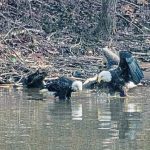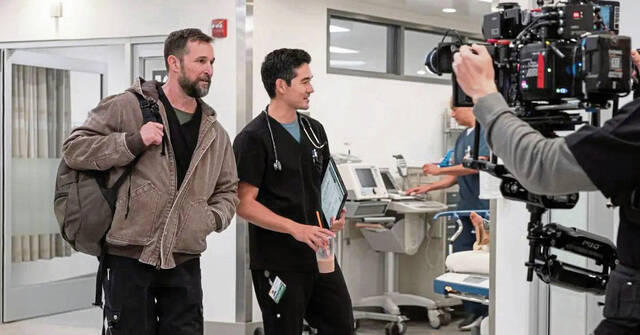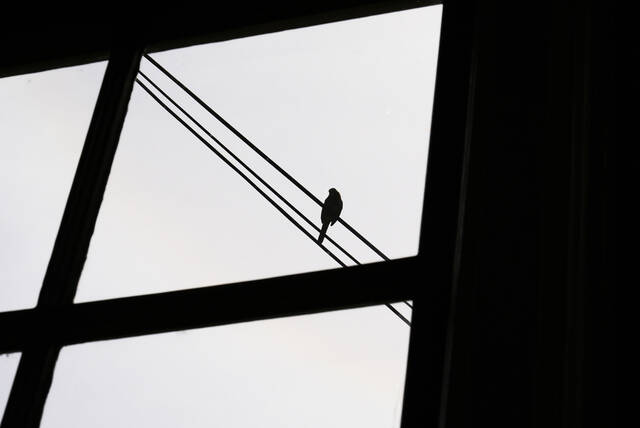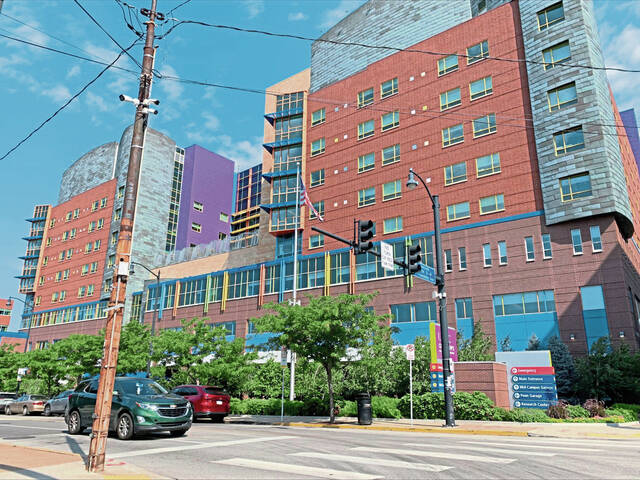A pair of bald eagles chose another unlikely urban spot to nest in the once highly industrialized Pittsburgh area — the U.S. Steel Irvin plant in West Mifflin along the Monongahela River, across from Glassport.
There are no other known eagle nests in the state at a steel mill, making the Irvin plant nest a first, according to the Pennsylvania Game Commission. However, as populations of the formerly endangered, national emblem rebound, more bald eagles are choosing to raise families in urban and suburban areas around the state.
“There are more nests occurring in places we historically thought eagles wouldn’t nest,” said Sean Murphy, Pennsylvania Game Commission ornithologist.
Murphy, who grew up in the Mon Valley in West Elizabeth, added, “That stretch of the Monongahela River would be the last place to find top predators known for fishing in pristine lakes and rivers.”
Audubon Society of Southwestern Pennsylvania Executive Director Jim Bonner also grew up in the Mon Valley, across the river from the Irvin works in Glassport. He remembered that at the height of steel mill activity, “When the snow fell, if you weren’t out in the first five or ten minutes, it would be covered in soot.”
The nesting eagles are exciting, he said.
“It is something I could not have imagined as a kid,” Bonner said. “And it is a testament to — if you give nature a chance, it can rebound.”
The workers at the plant also enjoy the eagles.
“I have 800 workers who think it is cool we have a bald eagle,” U.S. Steel Irvin Plant Manager Don German said.
The mill has protected the wooded areas around the plant where bluebird boxes have been placed and other wildlife such as turkey and deer are commonly seen.
In early 2020, Robert Bevan, a water treatment operator at the Irvin plant, saw the eagle pair carrying some sticks to a tree.
“It’s a big deal to see the eagles, especially when, say, I’m clearing out the intake for water from the river to the plant,” he said.
When the birds nested last year, successfully rearing one eaglet, plant workers — who dubbed the couple Clair (after U.S. Steel Clairton works) and Irvin — didn’t want the public to know until the birds got established, Bevan said.
“Personally, this is so cool,” he said. “When I was a kid, I liked bald eagles and the only two I could see were (stuffed ones) at the Carnegie Museum.” Then, less than a decade ago, Bevan visited the photographers downriver near the Hays bald eagle nest. “It was like I saw a mythical creature,” he said. “We have something special here. It’s awesome.”
Eagles and their offspring continue to creep into nesting sites with heightened levels of human disturbance, Murphy said. “Birds are growing up and looking for new nest sites and the old threats are not considered threats, such as industrial noise and traffic.”
There are some notable bald eagle nest sites in non-traditional places, including 150 yards from the clubhouse of a golf course in south-central Pennsylvania and along a busy six-lane highway and cloverleaf intersection in the middle of the state, Murphy said.
But in the Pittsburgh area, the bald eagles are choosing urban areas. Currently three of the five active bald eagle nests in Allegheny County are located in the Mon Valley: In addition to the U.S. Steel Irwin plant, there’s the Pittsburgh Hays nest, with three eggs, and state game wardens report eagles are sitting on eggs at nests near McKeesport along the Youghiogheny River near its confluence with the Mon.
Douglas Bergman, a game warden with the Game Commission who covers parts of Allegheny County, said he was not surprised that eagles were nesting at the steel plant.
“They feel safe there,” he said. The water is clean enough to support lots of fish, the eagle’s favorite food. “One of their nesting requirements is having a good food supply,” Bergman noted. The steep undeveloped cliffs along the Mon keep the birds safe from intrusion, he added.
These aren’t just urban nests — they are sited along the Monongahela in areas that were among the most polluted in country. At one time, the Monongahela River was the dumping grounds for the mills.
During much of the 20th century, the Monongahela River was devoid of fish and too acidic for people to swim in, even dissolving steel gates at some of its lock and dam structures, according to a report from the Pennsylvania Fish and Boat Commission.
“Up until the 1970s, the convenience of using the Three Rivers as a sink for decades of municipal and industrial wastes trumped requirements for potable water in Western Pennsylvania,” the commission said in a history report. Fish kills made national news.
At one time, sewage-contaminated drinking water from Pittsburgh rivers resulted in the region having the highest typhoid fever death rate in the United States.
The rivers cleaned up in recent decades with the federal Clean Water Act and other pollution laws, advancements in waste water treatment, and the collapse of heavy industries such as steel with the shuttering of 10 major steel mills in the region in 1980s, according to the commission.
“The water quality and fish populations in the three rivers have improved drastically over the last 50 years,” said Gary Smith, fisheries manager for the Pennsylvania Fish and Boat Commission for the southwest region.
In the late 1960s, only a few fish species were collected in the Monongahela River. Today, at least 76 fish species have been collected throughout the Monongahela River, he said.
Allegheny County’s other active nests this year include Harmar, where the Harmar Bald Eagles of Pittsburgh Facebook page and local photographer report that the birds are incubating at least one egg. The Game Commission reported that the eagle pair in Crescent Township are also on the nest. Although there is a nest in North Park, the female of the pair that attempted nesting this year has gone missing. However, eagles have been reported in the area but there is no active nesting at this time.
There are more than 300 eagle nests in Pennsylvania, Murphy said.















